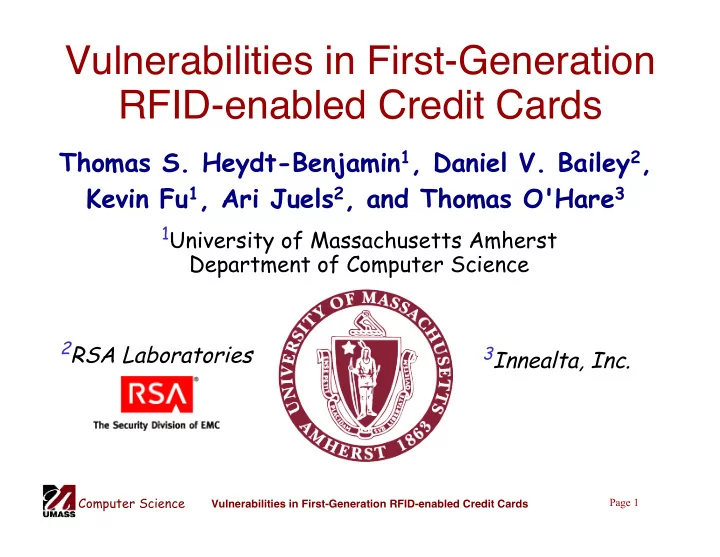

Vulnerabilities in First-Generation RFID-enabled Credit Cards Thomas S. Heydt-Benjamin 1 , Daniel V. Bailey 2 , Kevin Fu 1 , Ari Juels 2 , and Thomas O'Hare 3 1 University of Massachusetts Amherst Department of Computer Science 2 RSA Laboratories 3 Innealta, Inc. Computer Science Page 1 Vulnerabilities in First-Generation RFID-enabled Credit Cards
What are RFID Credit Cards? • Small mobile computing devices • Transmit credit card information to reader over RF • Passive 13.56MHz RFID transponder (ISO 14443-B) – Read range unknown, suspected to be around 10cm to 30cm • “fastest acceptance of new payment technology in the history of the industry.” [VISA; As reported in the Boston Globe, August 14 th 2006] Computer Science Page 2 Vulnerabilities in First-Generation RFID-enabled Credit Cards
An RFID Credit Card Purchase • User “Alice” authorizes purchase by simply bringing card into proximity with reader • Some kinds of fraud can be detected or prevented by the back-end charge processing network • Charge processing networks are complex and heterogeneous • In this work we primarily consider the security of the RF portion of the transaction COMPLEX! Computer Science Page 3 Vulnerabilities in First-Generation RFID-enabled Credit Cards
Some of the data revealed over RF •Credit card number •Cardholder name •Expiration date • Exceptions: – One type of card uses separate numbers for front of card and RF interface. – We have recently observed cards that withhold the Cardholder name Computer Science Page 4 Vulnerabilities in First-Generation RFID-enabled Credit Cards
Talk Outline • Background – What vulnerabilities exist? • Selected Experiments – How can the vulnerabilities be demonstrated? • Countermeasures – How can the vulnerabilities be mitigated? Computer Science Page 5 Vulnerabilities in First-Generation RFID-enabled Credit Cards
What Vulnerabilities Exist? • Personally Identifying Data (PID) Disclosure – Credit card or other user specific data disclosed – Financial fraud is not the only reason to protect PID • Consumer confidence • Legal concerns • Cross-Contamination – Data from RF transmission used in a different context – For example; a web purchase Computer Science Page 6 Vulnerabilities in First-Generation RFID-enabled Credit Cards
What Vulnerabilities Exist? • Replay – Data obtained over RF are played back by adversary • Relay – Queries from reader relayed by adversary to credit card without Alice ’ s knowledge or consent • Many other RFID privacy vulnerabilities – For example: [JMW05] Computer Science Page 7 Vulnerabilities in First-Generation RFID-enabled Credit Cards
Eavesdropping • Equipment: Antenna, Oscilloscope, Laptop • Demonstrates: – Data disclosed in the clear before any challenge-response – No authentication of reader Computer Science Page 8 Vulnerabilities in First-Generation RFID-enabled Credit Cards
Cross-Contamination • Are PID disclosed sufficient for financial fraud? – Maybe… – CVC absent from RF data, card face, mag-stripe – Collection of CVC varies with merchant and transaction type • In some cases, yes: We successfully performed a purchase – New credit card in sealed envelope – Scanned card with programmable RFID reader kit – “Alice ’ s” address retrieved from phone book Computer Science Page 9 Vulnerabilities in First-Generation RFID-enabled Credit Cards
Replay: Credit Card Cloning • Some cards: data sent to commercial reader is always the same with successive transactions • We built a device that can replay these data • Commercial readers accept the replay Computer Science Page 10 Vulnerabilities in First-Generation RFID-enabled Credit Cards
Replay and Transaction Counters • Some Cards: counter increases with each RF transaction • Unfortunately counters create a race condition “1” Computer Science Page 11 Vulnerabilities in First-Generation RFID-enabled Credit Cards
Replay and Transaction Counters • Under some circumstances counter prevents replay “Approved” “2” “Alarm!” “1” Computer Science Page 12 Vulnerabilities in First-Generation RFID-enabled Credit Cards
Replay and Transaction Counters • Some times the counter will not prevent replay “Approved” “1” “Approved” “2” Computer Science Page 13 Vulnerabilities in First-Generation RFID-enabled Credit Cards
Replay and Challenge-Response • Some cards use a challenge-response protocol – Details of algorithm unknown – Can protect against replay if back-end network is configured correctly – Challenge-response not used for protecting PID Computer Science Page 14 Vulnerabilities in First-Generation RFID-enabled Credit Cards
Countermeasures • Faraday cage – Doesn ’ t protect during use ??? • Recent cards omit cardholder name – Caution: This lowers the bar on other attacks Computer Science Page 15 Vulnerabilities in First-Generation RFID-enabled Credit Cards
Countermeasures • Better use of cryptography – Some current cards may use cryptography – All we have seen transmit credit card data in the clear • Smarter devices [Chaum 85] – Easier to assure user consent – More resources for cryptographic protocols Computer Science Page 16 Vulnerabilities in First-Generation RFID-enabled Credit Cards
The big problem: Paradigm shift • Most of the vulnerabilities for RFID credit cards are similar to those for the EMV cards in previous talk • The same attacks are, however, much easier in the wireless paradigm • PID disclosure in particular must be thought of quite differently Computer Science Page 17 Vulnerabilities in First-Generation RFID-enabled Credit Cards
Conclusion • Current RFID credit cards are vulnerable to PID disclosure, cross-contamination, relay, and to some extent replay • End to end communication between card and back- end mitigates some but not all vulnerabilities • Financial companies must not only think about fraud, but also about other consumer rights and concerns • Mechanisms for fixing most of these vulnerabilities already exist Computer Science Page 18 Vulnerabilities in First-Generation RFID-enabled Credit Cards
Recommend
More recommend